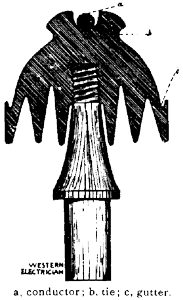[Trade Journal]
Publication: Western Electrician
Chicago, IL, United States
vol. 19, no. 9, p. 100, col. 1-2
Niagara Falls-Buffalo Transmission
Line.
Work on the transmission line between Niagara Falls and Buffalo is well under way. The special requirements of this project are great strength and perfect insulation. The poles are of round cedar, shaved and painted, with nine and 10 inch tops, and will vary in length from 35 to 50 feet, according to the nature of the soil in which they are placed. The cross-arms are of hard yellow pine, four by six inches and 12 feet long, dressed and painted. The cross-arm braces are of special design. They are made of one-quarter by 2-1/2 inch angle iron formed hot and bored for log screws. Each brace weighs about 20 pounds. There will be two cross-arms on each pole and on the ends of each arm iron pins will be set in order to prevent the conductor from falling to the ground should the tie-wire loosen or the insulator break. The pins on the upper arms will also carry barbed fence wire of galvanized iron for lightning protectors. Another fence wire will be strung along the top of the poles for the same purpose. These wires will be grounded at the foot of every fifth pole.
The strain on the poles will be enormous from the weight of the wire alone, if the plans of the power company are ever carried out. Provision is made for 12 conductors of stranded bare copper wire, each of 350,000 circular mils. Every pole will have to support about 1,200 pounds of copper. The strains to which the poles and lines may be submitted have been very accurately worked out. A factor of safety has been allowed providing for the whole line being covered with half an inch of ice. The effects of induction will be overcome by a transposition of the conductors from pole to pole. Complete transposition is made every five poles.
 |
| Niagara Falls-Buffalo Transmission Line. |
Not the least interesting feature about this transmission line is the insulator that will be used. It is of special design and is made of porcelain and proportioned so as to protect all weak points, combining uniform strength with a large insulating surface. On the outside petticoat is a gutter constructed so as to drain away the water clear of the cross-arm. This will prevent the formation of icicles on the insulator at any place where they could touch the cross-arm. As will be seen from the accompanying cut, none of the weight of the conductors lies on the tie-wires, as is ordinarily the case.
The poles will be set in rock or concrete, as the nature of the soil requires. The entire line will be fenced in to guard against interference, and it is quite probable that it will be watched by patrols.
It is announced that 5,000 horse power will be delivered in Buffalo the first of November. Each half of the cross-arms will support three conductors, and these combined will finally have a total capacity of 20,000 horse power.
